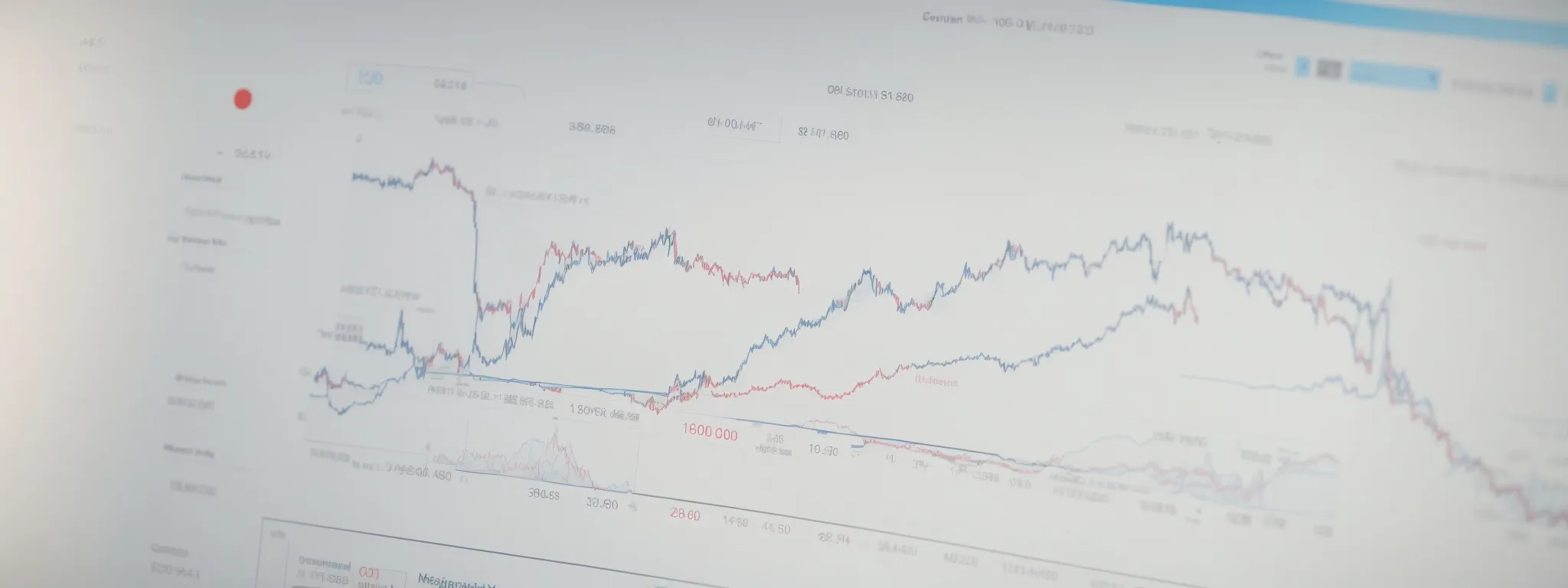SEO Forecasting Models Failing
Why SEO Forecasting Models Fail: Uncovering the Pitfalls In the rapidly evolving landscape of digital marketing, businesses clamor for tools that can predict trends and outcomes with […]
Why SEO Forecasting Models Fail: Uncovering the Pitfalls
In the rapidly evolving landscape of digital marketing, businesses clamor for tools that can predict trends and outcomes with precision, leading to an increased dependence on SEO forecasting models.
These intricate systems promise to decode the future of website traffic and ranking positions, yet often they implode, creating a perplexing labyrinth for SEO professionals.
The failure of SEO forecasting models typically stems from a misunderstanding of the myriad factors influencing SEO, an overreliance on questionable data, and models that are out of sync with the company’s objectives.
Furthermore, these models grapple incessantly with the dynamic nature of search engine results pages (SERPs), where algorithm changes can render yesterday’s insights obsolete.
Unveiling the inherent challenges of these forecasting models necessitates a deep and nuanced understanding of the SEO terrain—only then can one anticipate and navigate the potential downfalls.
Keep reading to discover why even the most advanced models can falter, and how LinkGraph’s SEO services can provide a more strategic compass for your SEO efforts.
Key Takeaways
- SEO Forecasting Models Require Constant Updating to Account for Search Algorithm Changes
- User Behavior and Competitor Movements Are Critical Factors Often Overlooked in SEO Forecasting
- SEO Strategies Must Be Tailored to Each Website’s Unique Characteristics and Business Objectives for Accuracy
- Conversion Metrics and Customer Journey Mapping Are Essential for Effective SEO Outcomes
- Complexity in SEO Modeling Does Not Always Equate to Precision and Must Be Balanced With Actionable Insights
Misunderstanding the Complexity of SEO Factors

In the intricate landscape of digital marketing, SEO forecasting models are often revered for their predictive capabilities, guiding organizations in optimizing their online visibility.
However, these models can falter, primarily due to a misinterpretation of the SEO environment’s complexity.
Models may fail to capture the dynamic nature of search engine algorithms, which evolve frequently and sometimes radically.
They might also not account for the shifting patterns in user behavior, which can dramatically alter search query relevance and traffic.
Furthermore, competitor movements can significantly reshuffle rankings, yet they are frequently undervalued in forecasting models.
These oversights lead to an incomplete analysis, jeopardizing the accuracy of SEO projections and the strategic decisions based upon them.
Ignoring the Evolution of Search Algorithms
At the heart of the inaccuracies in SEO forecasting models lies a tendency to overlook the ongoing evolution of search algorithms. These complex, machine learning-driven processes grow more sophisticated daily, outpacing models that base their predictions on outdated understandings of search engine behaviors.
Enhancements to algorithms intended to refine user experience can render prior SEO data and strategies ineffective overnight. As such, organizations that rely on static forecasting models without regularly incorporating algorithmic updates risk the obsolescence of their SEO efforts.
- Models failing to update algorithmic changes risk inaccuracy.
- Reliance on outdated data compromises SEO strategy effectiveness.
- Constantly evolving search processes require adaptive models.
Overlooking the Impact of User Behavior Changes
As digital landscapes shift, so too do the behaviors and expectations of users, and these changes have a profound impact on search patterns and website traffic. SEO forecasting models often miss the mark by not incorporating these behavioral trends, leading to projections that may fall short of actual user interaction with the search results.
With new platforms emerging and online experiences becoming more personalized, user behavior continues to evolve, requiring SEO methodologies to adapt accordingly. Models that neglect to integrate these behaviors leave companies vulnerable to misguided SEO strategies, which can divert resources away from more effective avenues of user engagement.
Not Considering the Role of Competitor Movements
In the cutthroat arena of search engine rankings, competitor movements can be as unpredictable as they are influential. When SEO forecasting models omit the direct and indirect effects of competitors’ strategies, they present incomplete projections that could mislead a company’s campaign direction.
Competitors’ SEO tactics, from white-label link building to sudden shifts in SEO content strategy, can result in rapid and substantial changes in ranking positions. Recognizing and assimilating these competitive strategies into forecasts is crucial for maintaining the validity of an SEO projection.
| SEO Aspect | Importance | Typical Model Coverage | Implications of Oversight |
|---|---|---|---|
| Algorithm Updates | High | Low | Risk of outdated SEO strategies |
| User Behavior | High | Medium | Misaligned user engagement approaches |
| Competitor Movements | High | Low | SEO strategies may be rendered ineffective rapidly |
Overreliance on Inaccurate Data Sources

Businesses often undertake SEO campaigns with the best intentions, yet missteps in practices such as inaccurate data sourcing can degrade the reliability of SEO forecasting models dramatically.
Many models are constructed on a substrate of keyword datasets and analytics that, while appearing robust, may be antiquated or derived from unreliable third-party sources.
Furthermore, the public search volume data they utilize is frequently an approximation at best, distorting potential market insights.
The pitfalls associated with such modeling can manifest in multiple dimensions—a fixation on stale keyword data can skew an SEO strategy, misplaced trust in unverified analytics can dilute campaign effectiveness, and misconceptions born from the use of limited public search volume information can further deviate outcomes from business objectives.
The Dangers of Using Outdated Keyword Data
In the rigorous scope of SEO, choosing the right keywords serves as the underpinning of a successful strategy. However, relying on outdated keyword data can lead companies to chase shadows, devoting resources to optimize for search terms that have declined in relevance or volume.
The dire consequence of this misstep is the misalignment of an SEO campaign with the current market conditions. Seemingly minute discrepancies between present user searches and historical data can culminate in a wide chasm, undermining the objective to secure a prime search engine presence.
| SEO Element | Impact of Using Outdated Data | Resulting SEO Challenge |
|---|---|---|
| Keyword Relevance | Decreased traffic potential | Misguided content focus |
| Search Volume Accuracy | Potential overestimation of market size | Erroneous forecasting and resource allocation |
Trust Issues With Unverified Third-Party Analytics
Discerning the credibility of analytics can present a significant hurdle in accurate SEO forecasting. The reliance on third-party analytics, without stringent verification, may lead to foundational errors in SEO strategy development: a miscalculation that diminishes the competitive edge.
- Verifying third-party analytics is critical to maintaining SEO accuracy.
- Unverified data sources can lead to strategic errors, impacting competitiveness.
- Erroneous analytics undermine SEO campaigns and decision-making.
Analytics drawn from unconfirmed sources can steer an SEO Campaign Into the Vast Sea of the internet with a faulty compass. This situation is akin to navigating without a reliable map, potentially resulting in misdirected efforts and investments that falter in delivering the expected return on investment.
The Limitations of Public Search Volume Information
Public search volume data, commonly utilized in SEO forecasting models, often provides an inadequate representation of actual search behavior. This shortfall stems from the aggregated nature of such data, which tends to mask nuanced shifts in user queries, resulting in less precise targeting for SEO campaigns.
Consequently, when businesses depend on these broad estimations, there is a significant risk of crafting SEO strategies that fail to resonate with the specific intent behind user searches, potentially derailing efforts to enhance website traffic and online visibility.
The Consequences of Misaligning With Business Goals

When evaluating the viability of SEO forecasting models, the alignment with overarching business goals emerges as a pivotal area that organizations must navigate with precision.
Failure to meticulously map SEO outcomes to genuine business objectives can cause even the most refined models to miss their intended mark.
The perils of ignoring vital conversion metrics and the intricacies of Customer Journey Mapping are often overlooked, yet they play a critical role in achieving desired results.
The amplification of these aspects determines the impact of a holistic SEO strategy, which should not only elevate rankings but also forge a path for valuable user engagement and conversion rates that benefit the bottom line.
Failure to Map SEO Outcomes to Business Objectives
SEO strategies thrive when harmoniously integrated with a company’s core business objectives, yet this alignment is frequently amiss within SEO forecasting models. Discrepancies arise when models prioritize ranking improvements without considering the end goals, such as increased sales, lead quality, or customer loyalty, neglecting the nuanced connection between search engine visibility and real-world business outcomes.
Organizations that sidestep the crucial process of linking every facet of their SEO campaign, from keyword selection to content creation, with specific business goals inevitably encounter challenges. This oversight can lead to ineffectual efforts where notable rankings fail to translate into meaningful business growth and return on investment, underscoring the importance of SEO strategies that mirror a company’s ambitions.
The Perils of Neglecting Conversion Metrics in Predictions
Models that de-emphasize conversion metrics present a treacherous landscape for companies aiming to measure the true value of SEO activities. These metrics are the linchpin for understanding how website traffic translates into actionable business results, yet their absence from SEO forecasting models can lead to overestimation of success and misallocated resources.
Ironically, it is the conversion rates, not just traffic statistics, that determine a strategy’s viability in realizing business growth. Without integrating conversion metrics into forecasting, organizations risk having robust rankings intertwined with a disheartening lack of tangible business outcomes.
Losing Focus on the Customer Journey and Its Relevance to SEO
The intricacies of the customer journey often elude SEO forecasting models, detaching the strategy from the very users it aims to attract. Without a keen understanding of the myriad touchpoints a user encounters from initial search to final conversion, businesses risk crafting SEO campaigns disconnected from the true pathways customers traverse.
Inadequate consideration of the customer’s navigational experience can result in disjointed SEO efforts that, despite ranking success, do not foster deeper customer engagement or lead to conversions. Such oversight dilutes the potency of SEO initiatives, impeding the achievement of business milestones that hinge on customer-centric outcomes:
| Customer Journey Aspect | Business Impact of SEO Oversight | SEO Strategy Adjustment Required |
|---|---|---|
| User Search Intent | Lower conversion rates due to misaligned content | Tailor content to align with specific user intents |
| Engagement Touchpoints | Missed opportunities in nurturing potential leads | Implement strategies targeting each stage of user interaction |
The Fallacy of One-Size-Fits-All Models

The terrain of search engine optimization demands a bespoke approach; however, the industry often witnesses the adoption of standardized forecasting models, which mistakenly assume uniform efficacy across various Market Segments and Websites.
This misguided belief in universal KPIs neglects the unique characteristics of diverse market niches, potentially leading organizations to embark on a perilous path where ill-fitting models and generalized strategies misdirect their SEO campaigns.
An overarching reliance on a one-size-fits-all methodology fails to acknowledge the necessity of tailoring forecasts to the distinct digital footprint and campaign goals of each entity, compromising the precision and effectiveness of SEO initiatives.
The Myth of Universal KPIs in Diverse Market Niches
The industry’s adherence to standard KPIs across varying market niches is often misguided, as these metrics may not resonate with the particularities of specific segments. LinkGraph’s SEO services recognize this, emphasizing the customization of KPIs to align with the unique online ecosystem and competitive dynamics of each client.
Marketers must bear in mind that while traffic and rankings are ubiquitous KPIs, their relevance can drastically differ from one industry to another. For instance, local SEO services embody different success indicators than vast, international campaigns, a nuance well-understood and integrated within LinkGraph’s comprehensive SEO approach.
The Risks of Applying the Same Model Across Different Websites
Implementing identical SEO forecasting models across diverse websites can be likened to using the same prescription for different ailments: it overlooks the unique characteristics and needs of each site. A model that is finely-tuned for an e-commerce platform with copious product pages may falter when applied to a service-oriented business, where local SEO and trust signals bear more weight.
Adaptability is key, hence LinkGraph’s SEO services emphasize the tailoring of SEO strategies to the specific context and goals of each client’s online presence. The nuanced parameters of a website, such as domain authority, content structure, and user engagement, require distinct approaches for effective optimization and accurate forecasting.
- Different websites necessitate SEO models that account for their unique characteristics.
- Customized strategies lead to more accurate forecasting and improved SEO performance.
- LinkGraph’s bespoke approach ensures each client receives optimal SEO guidance.
The Error of Not Customizing Forecasting to Specific Campaigns
LinkGraph’s SEO services excel in understanding that no two SEO campaigns are identical; this is where the error of uniform forecasting models becomes apparent. Campaign-specific variables—such as target audience, geographic focus, and industry competition—demand bespoke models tailored to the nuances of each individual SEO project.
By disregarding the essential need for customization, organizations commit to a path of guesswork rather than informed strategy. Location, demographic, and user intent are just a few dimensions requiring scrupulous consideration in forecast modeling, ensuring alignment with the campaign’s intended outcomes:
| Campaign Attribute | Customized SEO Need | Impact of Generalized Modeling |
|---|---|---|
| Target Audience | Market-specific keyword and content strategy | Reduced engagement and relevance |
| Geographic Focus | Localized keyword optimization and link building | Misalignment with local search behavior |
| Industry Competition | Competitor benchmarking and strategic positioning | Inaccuracy in gauging market landscape |
Clients seeking SEO craftsmanship look to LinkGraph for tailored strategies that avoid generic trends, thereby ensuring a more accurate forecast for their campaign’s trajectory. Such precision enables more efficient allocation of SEO resources and grants clients a competitive edge in achieving their desired search engine rankings and business performance goals.
Forecasting Models Struggle With SERP Volatility

SEO forecasting models are definitive tools in a professional’s arsenal, yet their efficacy is often compromised by an underestimation of search engine results page (SERP) volatility.
The tumultuous nature of SERPs poses a significant challenge for prediction accuracy, as even the most sophisticated models grapple with the rapid evolution of algorithms, the fluctuating influence of SERP features, and the inherent unpredictability of organic rankings.
These elements introduce a staggering complexity to the forecasting process, demanding agility and insight beyond the capabilities of traditional models.
Acknowledging and adapting to these variables is imperative for developing reliable SEO strategies that align with the Fluid Reality of Digital Search landscapes.
Underestimating the Impact of Algorithm Updates
SEO forecasting models often stumble by not fully acknowledging the transformative impact of search engine algorithm updates. These updates can shift the digital terrain overnight, requiring models that are not only responsive but predictive in anticipating such changes to maintain strategic accuracy.
LinkGraph’s SEO services stand at the vanguard, embracing the challenge of Algorithmic Unpredictability. Their methodology prioritizes the adaptation of SEO strategies to align with the most current algorithmic criteria, securing their client’s competitive stance in an ever-evolving search landscape.
The Challenge of Predicting the Influence of SERP Features
The influence of SERP features such as featured snippets, local packs, and knowledge panels adds a layer of unpredictability to SEO forecasting. LinkGraph’s SEO services incorporate dynamic strategies that adapt to the ever-changing SERP landscape, ensuring that their clients’ digital presence remains prominent amidst these variables.
As serpentine as the algorithms themselves, the appearance and behavior of SERP features can alter user interaction with search pages. With a nuanced understanding of these complexities, LinkGraph’s SearchAtlas SEO software provides clients with an agile approach to maintaining visibility in a space where organic rankings are influenced by more than mere keywords and links.
Dealing With the Unpredictability of Organic Search Rankings
Organic search rankings are a tempestuous element, their ebb and flow are dictated by a myriad of factors unseen to the unaided eye. Projections fail when they underestimate the capricious nature of these rankings, where a site’s position can shift with user preference, algorithmic adjustments, or emergent market trends.
LinkGraph’s SEO services carve a path through this unpredictability with informed strategies and the continuous monitoring of SEO performance metrics. By harnessing both the prowess of machine learning and the ingenuity of seasoned experts, these services adjust in real time to the whims of organic search rankings:
- Continual assessment of organic traffic helps in recalibrating campaigns to user search behavior.
- Free SEO audits provide insights into potential vulnerabilities within SEO strategies.
- LinkGraph’s SearchAtlas SEO software tailors efforts to the distinct fluctuations of SERP landscapes.
The Technique Trap: Confusing Complexity With Accuracy

In the realm of search engine optimization, the allure of sophisticated forecasting models is undeniable.
Marketers and strategists often gravitate towards these well-engineered tools, entranced by the promise of precision in predicting website performance.
Yet, beneath the sheen of complexity, these models can harbor significant inaccuracies, muddling the true essence of SEO.
It is imperative to strike a balance, harmonizing the nuances of statistical methodologies with a tangible comprehension of the SEO environment.
The over-reliance on intricate models, absent of actionable insights, serves as a siren call leading many astray.
This introduction delves into the technique trap, challenging the misconception that complexity inherently equates to precision in SEO forecasting.
The Allure and Pitfalls of Over-Engineered Forecasting Models
In the quest for superior SEO outcomes, the appeal of sophisticated forecasting models is tangible; they promise an analytic haven for companies yearning for quantifiable predictions in their digital marketing efforts. However, the seduction of these intricate systems often overshadows their flaws, falsely equating complexity with precision.
The crux of the issue lies in how these elaborate algorithms obscure rather than clarify the path to SEO success: by focusing on nuance over actionable insight, they can misguide rather than enlighten. Their pitfalls encompass more than just the potential for inaccuracies; they inhibit adaptability and curb marketing agility:
- Over-reliance on elaborate models can lead to inflexibility in responding to real-time search landscape changes.
- Mistaking complexity for accuracy in forecasting impedes clear, strategic decision-making.
- Models overly concentrated on technical finesse may overlook the essential human elements of SEO, such as user behavior and intent.
Balancing Statistical Methods With Real-World SEO Understanding
Balancing statistical models with the tangible intricacies of SEO is akin to walking a tightrope; one must cautiously weigh the empirical evidence against the lived experiences of the end-users. This equilibrium is pivotal as it safeguards strategists from becoming ensnared in data-driven methods that may overlook the human elements at the core of search behaviors.
LinkGraph’s SEO services adeptly negotiate this delicate balance, merging the prescriptive power of machine learning with the perceptible shifts in user engagement. Their approach intertwines the analytical with the experiential, ensuring that forecasting models remain attuned to the fluidity and humanity of the digital marketplace.
Avoiding the Trap of Using Complex Models Without Clear Insights
Averting the peril of complex SEO forecasting models devoid of clear insights requires a firm commitment to relevance and applicability. SEO practitioners must ensure that any model employed not only embodies the sophistication of current technologies but also provides actionable guidance that directly correlates with on-the-ground marketing objectives.
LinkGraph’s SEO services excel in parsing through the complexities to deliver clear, insightful strategies. By favoring models that marry complexity with palpable, strategic insights, they equip organizations with the tools to navigate the nuanced SEO landscape effectively:
| Forecasting Model Trait | LinkGraph’s Approach | Organizational Outcome |
|---|---|---|
| Complexity of Model | Alignment with tangible results | Strategically actionable insights |
| Technological Sophistication | Integration of current SEO trends and behaviors | Informed and adaptive campaign decisions |
| Insight Applicability | Clear-cut strategies that address real-world challenges | Enhanced competitive advantage in the SEO space |
Conclusion
SEO forecasting models often fail due to their inability to accurately interpret the intricate and evolving nature of search engines, user behavior, and competitive dynamics.
Organizations frequently depend on these models to navigate the digital marketing landscape, but common pitfalls can significantly undermine their effectiveness.
Improper consideration of constantly changing search algorithms, evolving user behavior trends, and competitor strategies can lead to outdated and ineffective SEO approaches.
Moreover, reliance on inaccurate or outdated data sources—such as keyword relevance and third-party analytics—exacerbates the issue, steering SEO campaigns in the wrong direction.
The gap between SEO forecasting and business objectives is also a critical factor.
Models that do not align SEO outcomes with business goals or fail to factor in conversion metrics and the customer journey miss vital opportunities to drive tangible results.
Additionally, the fallacy of one-size-fits-all solutions does not account for the unique characteristics of different websites and market segments.
The volatile nature of SERP features and organic search rankings further adds to the unpredictability that these models struggle to accommodate.
Finally, the complexity of these models can become a trap, where sophistication is mistaken for accuracy, leading to over-engineered and inflexible strategies that fail to provide clear insights.
Successful SEO forecasting requires adaptive, tailored approaches that integrate up-to-date algorithmic understanding, precise market and user insights, as well as a refined balance between technical complexity and real-world SEO knowledge.
Organizations like LinkGraph, with bespoke and insightful SEO services, navigate these challenges more adeptly, offering strategies that are both sophisticated and directly tied to the unique needs of each campaign.














































































